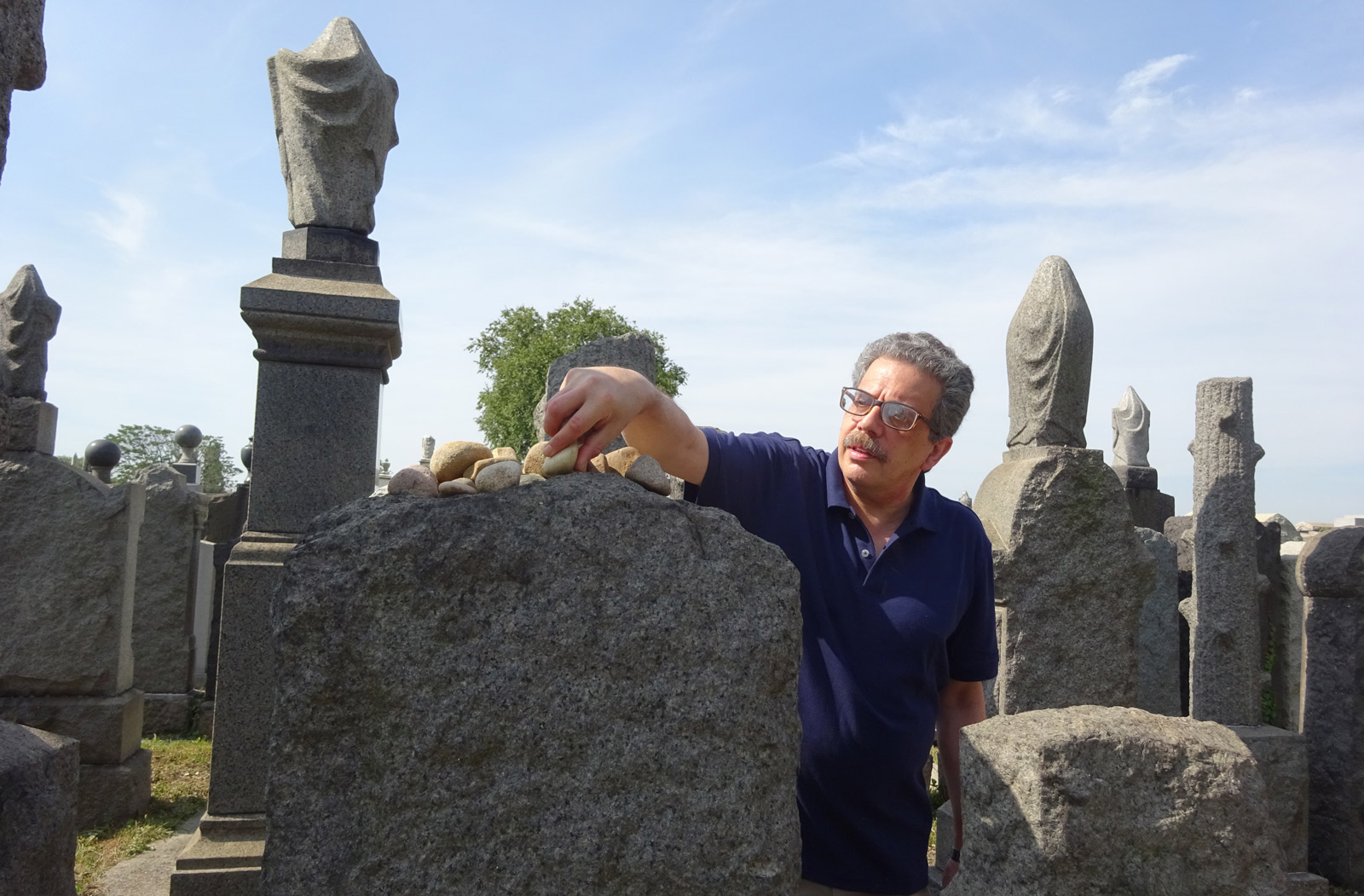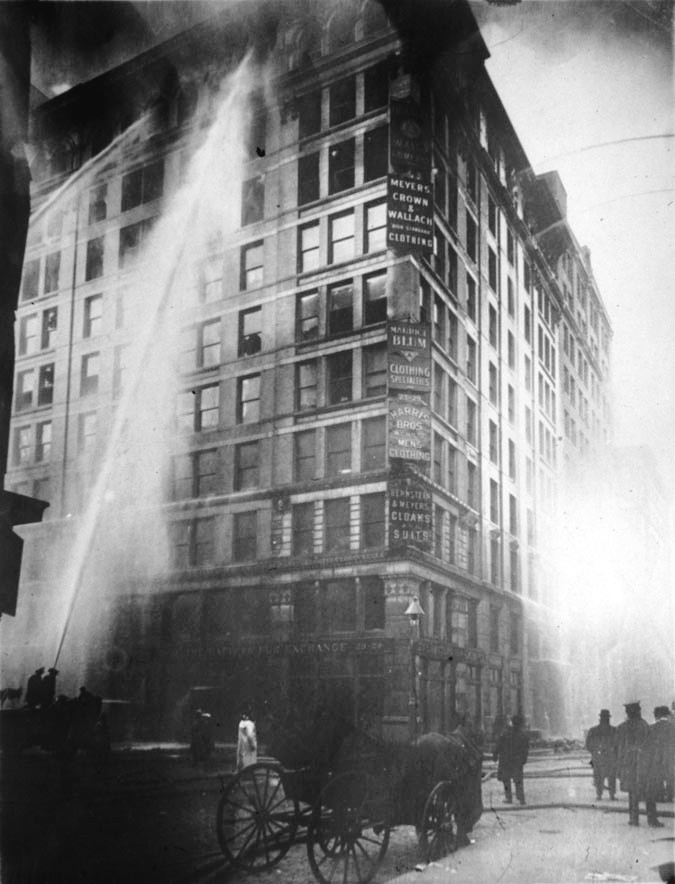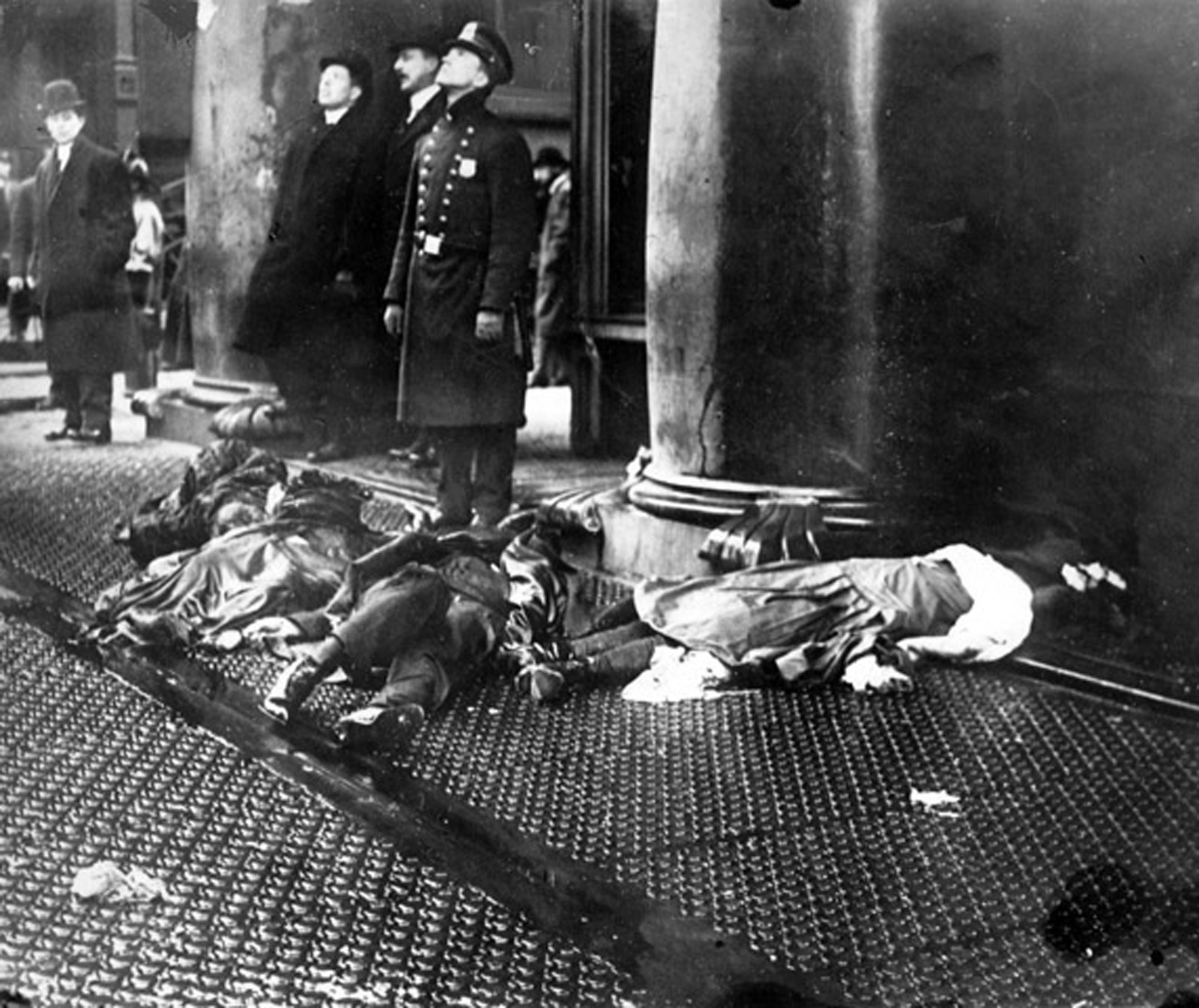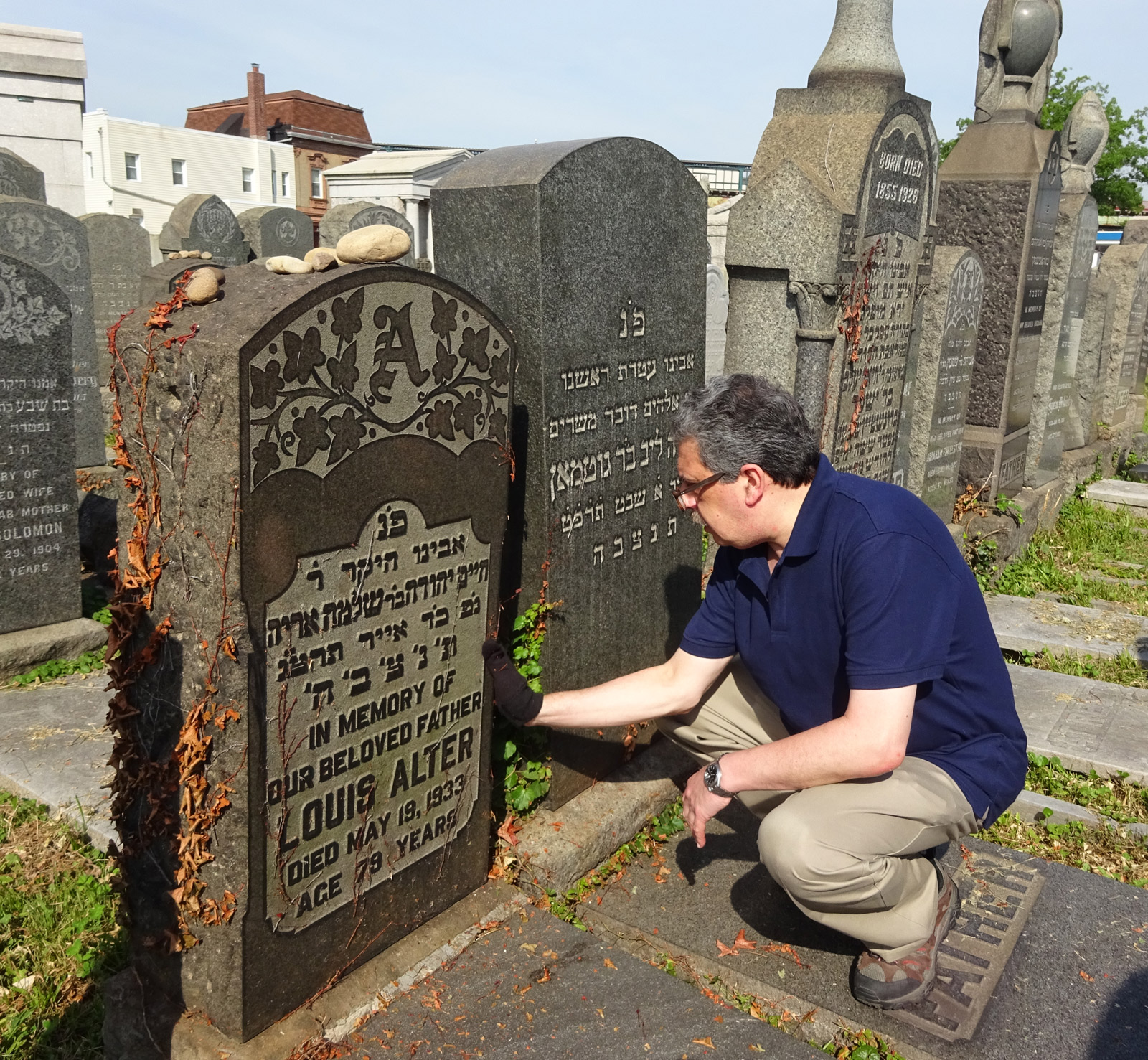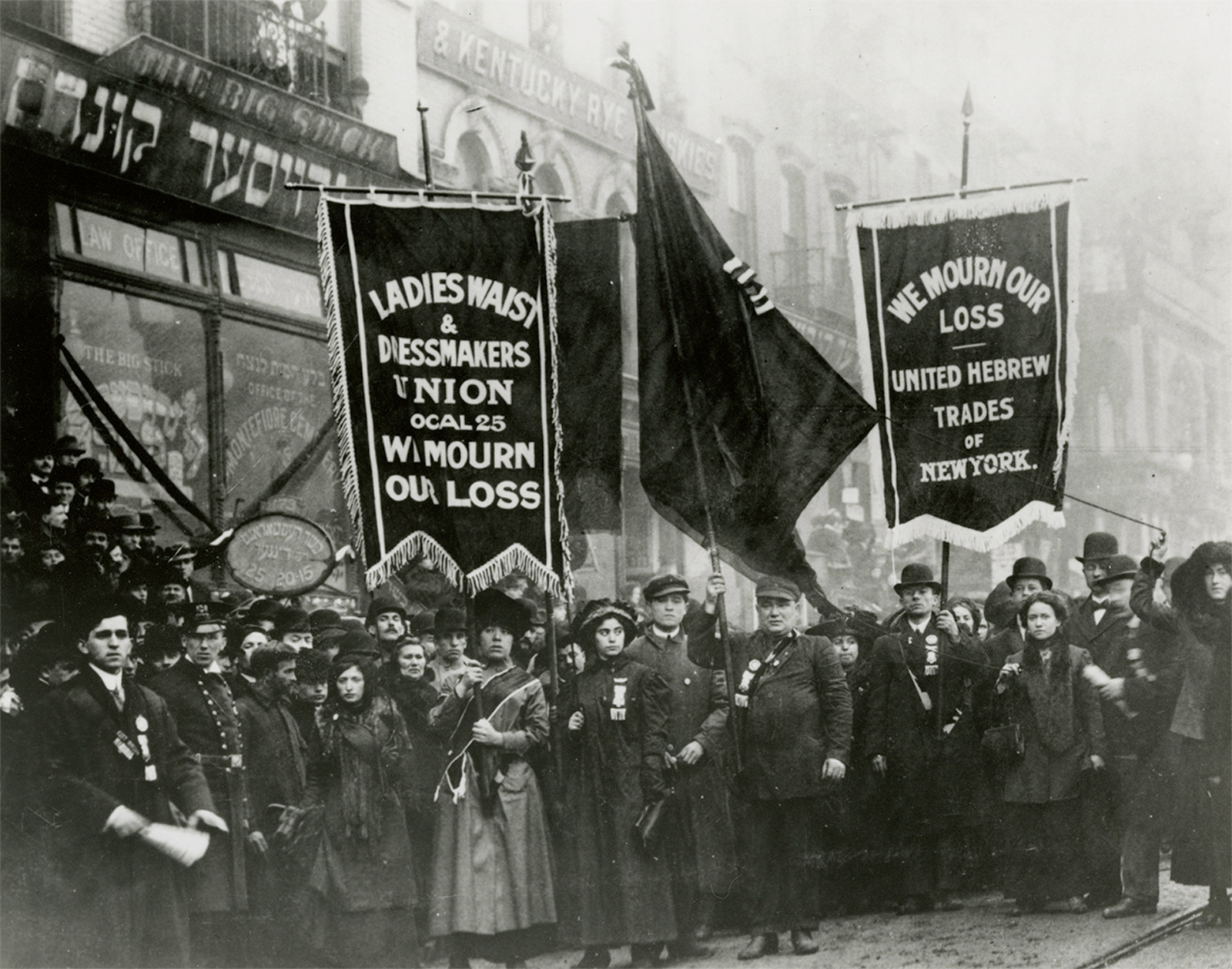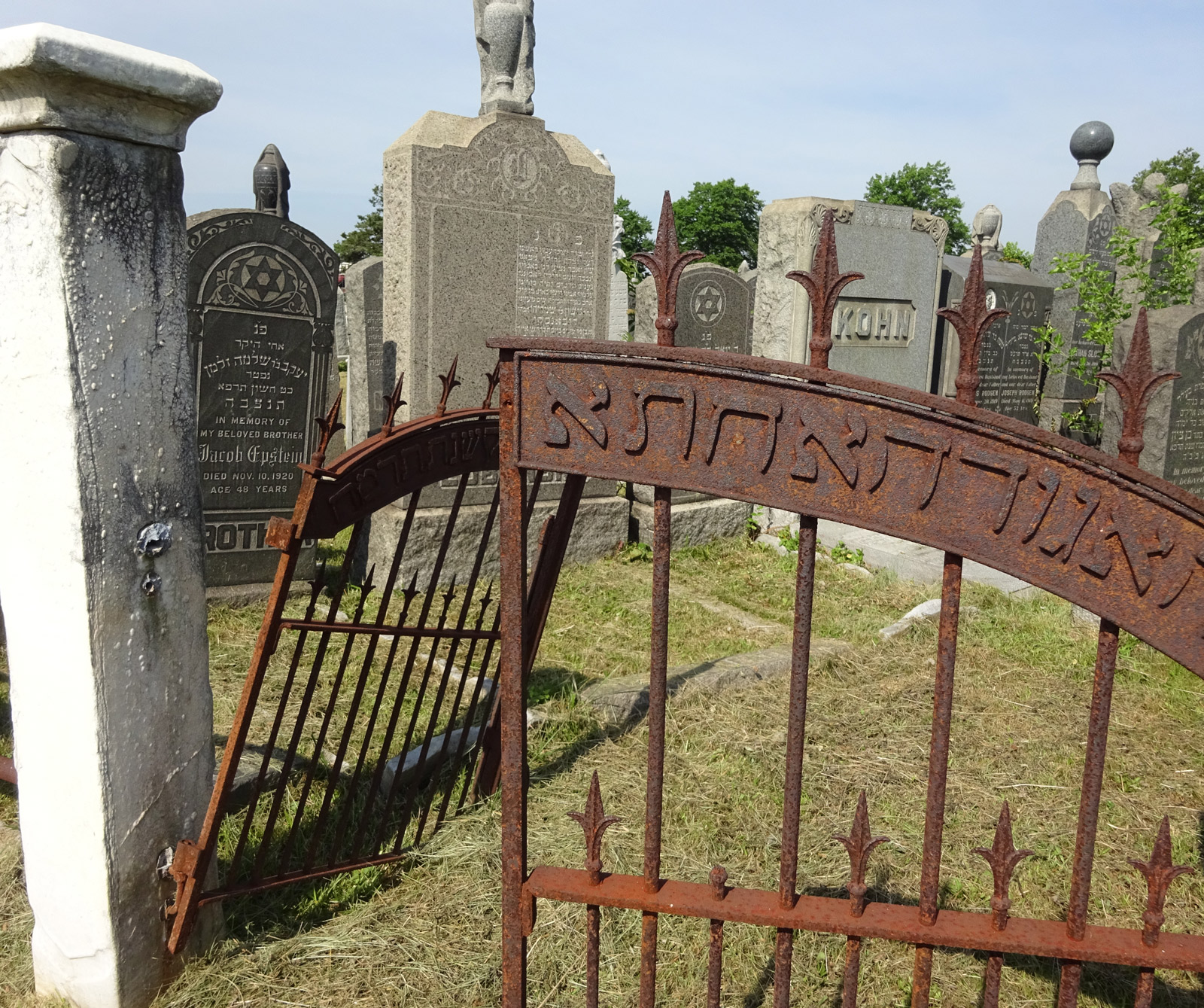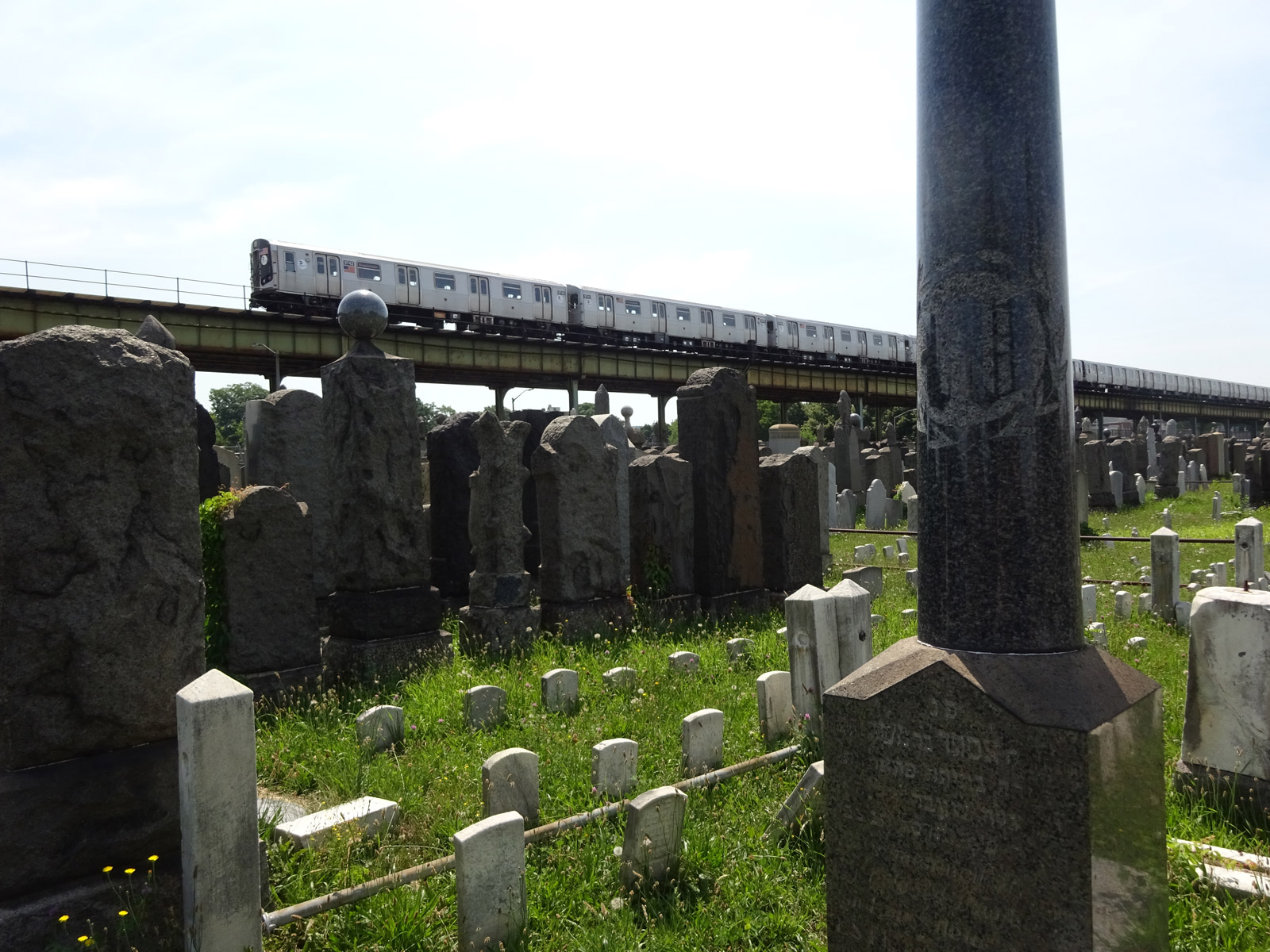On a hot mid-summer morning, Washington Cemetery in Brooklyn is blazing. Shadeless and weedy, it is occupied mostly by dragonflies and mockingbirds, along with a smattering of Italian wall lizards whose ancestors, according to legend, escaped from a pet store delivery truck in the Bronx back in the 1960s. The heat has them basking on tombstones, as if they were back in Tuscany, and they skitter away as I come walking through with Michael Hirsch, a genealogist and historian who has made it his mission to care for the graves of the victims of the Triangle Shirtwaist Factory fire.
It was the end of the workday on Saturday, March 25, 1911, when someone dropped a cigarette butt, or maybe a lit match, into a bin of scraps and sparked a fire on the eighth floor of the Asch Building near Washington Square. The flames spread fast, moving upward to engulf the three floors of the successful factory where garment workers cut and sewed ladies’ blouses. The majority of those workers were young immigrant women, primarily Italian and Jewish residents of the Lower East Side and Greenwich Village. Trapped and panicked, they died of smoke inhalation and burns. Some fell to their deaths when the fire escape collapsed. And many more leaped from the windows. In the end, 146 were killed in what was, until September 11, 2001, New York City’s deadliest workplace disaster.
Hirsch is sweating in the unrelenting heat. Instead of a jug of water, he carries a bag full of rocks. If he were Catholic, I’d say he was doing penance for some sins he can’t imagine will be forgiven. But he’s Jewish, dressed in a polo shirt, not a hair shirt, and the rocks are for placing on graves. Washington Cemetery is a Jewish cemetery and the placing of rocks or pebbles is tradition. “I do it so they’ll be remembered,” Hirsch says. He stops and tells me to look out at the gravestones. There is an ocean of them, spanning five sections of cemetery separated by avenues and bisected by the elevated F train. Most are old, some dating back to the 1800s, crooked and neglected. Hirsch wants me to see that they have no memorial stones placed on top of them. They have been forgotten, and it’s this forgetting that seems to pain Hirsch the most. Fighting the inexorable tide of time, he is determined not to let it happen.
Fifteen years ago, he picked up the book Triangle: The Fire That Changed America, by David Von Drehle. In the back of the book, the author supplied a list of the dead, something that had never been compiled before. At the top of the list was the name Lizzie Adler and her address on East 6th Street in the East Village, then the Lower East Side, of Manhattan. Hirsch happens to live on the same block. In that instant, he felt a connection to Adler. “She would’ve been my neighbor,” he says. “From my fire escape window I can see her building. Who was she? What could I know about her?”
These questions led him first to fill in the blanks—“Lizzie was a twenty-four-year-old woman from Bucharest in Romania,” he relates. “She was five feet, four inches tall with brown hair and hazel eyes. She’d been in the country only sixteen weeks when she died”—and then to find Adler’s grave, after two years of searching, in Mount Richmond Cemetery on Staten Island. Hirsch brought Von Drehle’s book with him that day, to see who else he might find buried close to Adler. He checked the list against nearby graves and located more victims of the fire: four men and four rows of women and girls. The name Bertha Wendroff stood out. It didn’t match the spelling of a similar name on Von Drehle’s list. In fact, many of the names didn’t match.
“I found an astonishing number of corrections,” Hirsch says, “and many interesting problems with the story. Since then, I’ve discovered new victims. I’ve been able to identify unidentified victims. I’m a crazy researcher. When I take on a challenge, I want to win. I really wanted to do justice for them and get their names right.”
He has done that, correcting and contributing to this piece of history, but his mission continues. Over the course of the year, every year, Hirsch visits sixteen different cemeteries in and around New York City. Typically, at least once a week he’s in a cemetery. He visits the graves not only of the forty-five Christians and 101 Jews who perished in the fire, but also of their family members, the survivors of the tragedy, and the family of the factory owners, Isaac Harris and Max Blanck, whom he calls “two of the most wrongfully vilified people in American history.” That’s one piece of the Triangle story he wants to set straight.
Advertisement
According to popular accounts, Harris and Blanck ran a miserable sweatshop, paid low wages, and locked their workers inside to prevent theft. Hirsch disagrees. “The Triangle factory was not a sweatshop,” he tells me. “At the time of the fire, it was in a state-of-the-art building with many safety features lacking in other buildings. It had electricity and indoor bathrooms. It had a fire escape, standpipes, and fire hoses. It had 230 fire buckets just in the Triangle space, much more than was typical.” As for the locked doors, Hirsch says, “My belief is that the doors only appeared to be locked.” They opened inward whereas, by law, they should’ve opened out. “When you’ve got twenty people pushing in a fire panic, all you need is someone to shout, ‘The door’s locked!’” The doors opened inward, Hirsch explains, because the building owner, not the factory owners, got a waiver from the city to install them that way, for convenience. He concludes, “Fire Marshall William Beers determined that the responsible party for loss of life was the New York City Buildings Department. Politically, however, that didn’t fly.” Harris and Blanck were tried on manslaughter charges and acquitted. In 1914, the families of twenty-three workers sued the building’s owner, Joseph Asch, who paid out $75 per victim.
The first grave we visit belongs to Louis Alter, a cousin of Isaac Harris and a tenth-floor supervisor who survived the fire and lived to be seventy-nine. Hirsch takes a work glove from his bag, pulls it on, and crouches down to wipe the headstone free of vines. He takes two rocks from his bag and places them atop the stone. “One for me and one for the family,” he says, meaning Alter’s living family members. Through his work, Hirsch has connected with many descendants of the victims and survivors. He takes them to the cemeteries and introduces them to their deceased. Some have become his friends. Others refuse to speak to him “for holding the opinion that the owners were decent people who didn’t murder their ancestors.”
“So many people don’t want to believe the things I’ve discovered,” says Hirsch. “Harris and Blanck paid their employees well and ran a clean plant. At the time, they were considered good employers. But they’ve since been turned into caricatures of evil capitalists.” And the person most responsible for that transformation, in Hirsch’s opinion, was Pauline Newman, a one-time Triangle worker, esteemed socialist, and legend of the labor movement. Through his research, Hirsch has come to the conclusion that Newman wasn’t always truthful in the way she depicted conditions at the Triangle Factory, and Hirsch is attached to truth even when it conflicts with his political values—he identifies as a socialist and is a strong supporter of trade unionism. Because of activists like Newman, the Triangle fire bequeathed a powerful legacy of new building safety codes, worker’s compensation, the growth of organized labor, and other progressive reforms in the United States. The Triangle story is not a bubble Hirsch wanted to burst.
“Ironically,” he says, “many of the people who damaged this history are my heroes. Newman and I would have had a lot in common politically, but she’s the one who corrupted the story. And the older she got, the more she corrupted it. She’s a trip! One of the greatest propagandists in American history—and right now we need more of her. We need 100,000 Pauline Newmans, rabble rousers and activists and propagandists on the left. But she totally wronged those men. For politics. Her story, without the corrections, makes for a better story, but the thing is, it’s all bullshit. It was crushing when I came to understand that.”
We walk to the next grave, down narrow paths, wading through dry drifts of cut grass, weaving between gravestones placed so close together it’s difficult to squeeze through. Hirsch tells me to be careful. “Don’t grab the stones for balance,” he says, “they’ll fall over and kill you.” He warns me about stepping on the fragile vault covers, but it’s impossible to walk without stepping on them. They shift underfoot, making a terrible hollow sound that belies the deep holes beneath. “Don’t fall through,” he says, and laughs, imagining his own accidental death one day. “It’s almost like the cemeteries are looking for new customers.”
Advertisement
We visit Rosie Weiner, who died in the fire, and then her sister, Esther, who died eight years earlier on the same day, March 25, 1903, hit by a trolley car at Bowery and Grand. In Judaism, the anniversary of a death is called a Yahrzeit. For the Weiners, they grieved two daughters on the same day, every year. “March 25,” Hirsch says, touching the stone, “must have been terrible for that family.” His circle of loss and care expands ever outward. He knows not just the fire victims and survivors, but their families, too. And he knows how they died. This one’s mother went from cancer. That one’s sister passed from tuberculosis of the bone. A granddaughter committed suicide in the 1970s.
We walk along the edges of the grass where the new graves are, all marked by shiny, ostentatious black headstones, each decorated with an engraved portrait of the dead. These are the Russians, Hirsch explains. He is grumbling about how they’re crammed into every available space, many of them covering up antique stones or gates, obscuring important historic information, when we come upon the only other living human we’ve encountered in the cemetery, a man sitting cross-legged under an umbrella in front of one of the Russian stones. He is painting over the etching, colorizing the portrait to bring life into the cheeks and eyes of the elderly couple buried below. He is Russian, too, but maybe not Jewish. On his shoulder is a faded tattoo of a grave. A raised square of dirt marked by a crucifix. When I point it out to Hirsch, noting the man’s dedication to his work, he says, “I haven’t gone that far. Yet.”
We visit Meyer Utal, one of the seventeen men who died in the fire, likely while helping to battle the blaze on the ninth floor. (Wikipedia says twenty-three men died, but Wikipedia is wrong according to Hirsch.) We visit Dora Welfowitz, who died of asphyxiation and burns. We visit Mary Alter, daughter of Louis Alter and second cousin to Harris, who was filling in at the switchboard that day. When the fire broke out, she alerted her employers and then fled to safety, without alerting the other floors. Hirsch puts a stone on her grave. “She was just a young kid,” he says. “She panicked. It’s understandable. But some of the descendants of the owners’ families are guilt-ridden to this day about the things that happened.”
We visit Rebecca Feibish, a teenager from Romania. She is buried near the cemetery fence where there are trees and I find a relieving patch of shade in which to stand. I don’t know how Hirsch does it. He has severe asthma and is allergic to just about every tree and plant that grows in New York City. I am wilting, but he does not step into the shade, choosing to stay close to the grave. A dog barks in a nearby yard while Hirsch tells me about Feibish. She was working on the eighth floor of the building. She was with a friend, but they broke apart in the chaos. Instead of getting on the elevator with her friend, like so many she leaped out the window.
Some victims jumped together, by twos and threes, wrapped in tight embrace. Some kissed each other goodbye before stepping into space. Some jumped with their hair and skirts on fire, plunging, as one witness recalled, “like a living torch to the street.” When firefighters arrived, their ladders weren’t tall enough to reach the factory floors. And their rescue nets weren’t strong enough. Some bodies broke right through. Others fell so hard they crashed through the glass-bricked sidewalk vaults. Bodies lay in heaps along the pavement. The gutters ran bloody, littered with the girls’ lost belongings: hair ribbons, handbags, rosary beads.
Hirsch puts a rock on Feibish’s grave. He places another on her mother’s and then her father’s, touching each headstone with his hand. When I ask him about this gesture, which he repeats at grave after grave, he says, “I can’t touch them, so I touch their stones. They must have suffered terribly.”
We walk on, through high grass and clover flower, across plots of children’s graves, little white stones clustered together. The F train rumbles past on the high track, glinting silver in the sun. Fleeing our footsteps, lizards scurry into the brush. Insects bite at my ankles and I slap them away. If they’re biting Hirsch, he doesn’t seem to notice. I keep asking what drives him to dedicate so much time and effort to this punishing work. It’s not just the placing of stones. He regularly performs what he calls guerrilla gardening, “because I don’t have permission, but I do it anyway.” Out on Staten Island, when he first found the grave of Becky Neubauer, who died from the fire at age nineteen, it was in terrible condition.
“She was engulfed in poison ivy,” he says. Like many of the victims, Neubauer’s body was interred in a section with the members of her burial society, the organization that tends to the burials of Jewish people. “The whole society was just covered in vines. A whole canopy of poison ivy.”
On Labor Day, to honor Neubauer as a worker, Hirsch took it upon himself to singlehandedly clean up the massive tangle of poison vines. On a YouTube video that he posted of the gravesite, it looks like a jungle, nature taking over the gray stones, barely visible inside the green grip of vegetation.
“I got a Hazmat suit, rubber gloves, a mask, and booties,” he tells me. “It was blazing hot. I couldn’t get anyone to help me. I spent a week by myself just clearing out the poison ivy. I cleaned the whole fucking burial society. Eight rows of graves. Sixty-four people.”
Again, I ask him why he does it.
“I made promises to these people,” he says. “I don’t pray or believe in ghosts. But I’ve made pledges to these people that I’ll come back and take care of their graves. Or that their families will come and visit them. I don’t believe in an afterlife, but I’m speaking to their memory. People are touchstones to our history. I’m connecting to our history. We’re in trouble in society because people have abandoned our history. People don’t give a shit. This is an act of remembrance. It’s connecting with the larger story—the Jewish story, the Lower East Side story, the American story. It’s the immigrant story. And it’s my story, too.”
We visit Mary Leventhal, a bookkeeper at the factory who died in the fire at age twenty-two. “People were devastated by her death,” Hirsch tells me, as he leaves a stone. “She was beloved at the factory. I heard she was very attractive. Her body was found on the ninth floor. It was unrecognizable. She was badly disfigured. It was an effort led by the owners to try and identify this woman.”
We visit Ida Kanowitz, dead at nineteen. Hirsch gets out a pair of clippers and squats down to cut away an intruding bush. “It’s not supposed to be here. It’s blocking her grave,” he says. The clippers trigger an association and he tells me about Joseph Zito, one of the fire’s survivors, an Italian immigrant who ran an elevator at Triangle, keeping it going while the factory burned, saving many of the workers. “From the final elevator trip,” Hirsch says, “Joe Zito bore the scars from people who cut him with their scissors, fighting to get on. They knew it was the last car. Now he’s buried in an unmarked grave in New Jersey. He had a tough life.”
I keep pressing Hirsch for answers about why he does what he does. Every week, all year long. In hot sun and freezing snow. With asthma, bugs, and poison ivy. For people he did not know. For ghosts he doesn’t believe exist. As a psychoanalyst, I want to understand the deeper reasons for why people do what they do. With Hirsch, I don’t feel like I’ve gotten to it. Maybe it’s not for me to get. I try not to push too hard. I avoid the word “obsession.” I ask, “Are you atoning for something?”
Hirsch stops and takes this in. “It’s a good question,” he says. He thinks about it for a minute, dredges up a school-age memory of selling his soul to another boy for the money to buy Adidas track shoes, but then he discards it. That doesn’t feel like the answer. He shrugs, says he doesn’t know, and we walk on to the next grave. Then the next one. And the next.
“Look at the stones,” he tells me again, pointing out at the expanse. “All of them were human beings. I feel a closeness to them. I feel a kinship with these people in the ground. Like family. Someone once told me, ‘Family are the people who know your story.’ I know their stories. I do this as a mitzvah, an act of charity. There’s no greater mitzvah than doing something for people who can’t do it any longer. Coming to a grave is one of the highest mitzvahs. And it’s something where you can never be thanked.”
Hirsch plans to write a book one day, to set the record straight and further memorialize the dead, but he hasn’t started writing. It’s all research. There’s more to do. “My work now is about finding everybody,” he says, and I think he means every victim, every survivor, every mother, father, sister, and brother. The Triangle tragedy expanding ever outward, from the Lower East Side back to Bucharest, back to Russia, back to Italy. A thread of grief connecting all the immigrants, a thread that maybe connects back to Michael Hirsch, too.
After three hours, exhausted and sunburned, I have to go. Hirsch remains. He has hours of work left to do. He accompanies me to the subway and we say good-bye. As I climb the stairs to the elevated platform, I watch him go, back into the cemetery, to do the work for which he can never be thanked. I watch him until he disappears into a sea of gray stone.


